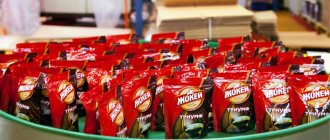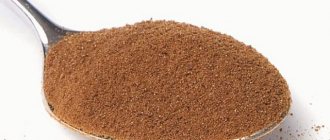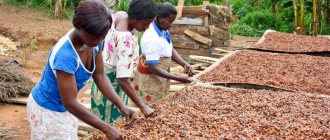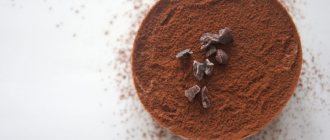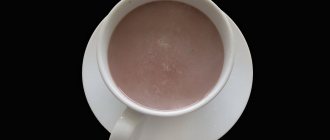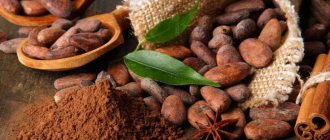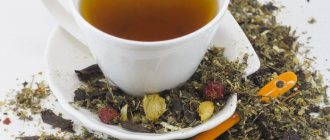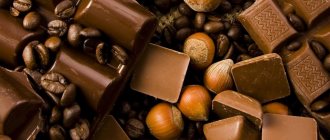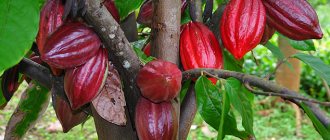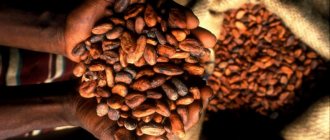What is the difference between coffee and cocoa? At first glance, it seems that they look very similar and have something in common. They grow in tropical forests, are roasted, sold as beans, and their beans are ground. But no one really knows what the difference is?
Coffee lovers already have various ways to prepare a flavorful drink based on their tastes and preferences. Cocoa beans and coffee, after certain processing, become the base product for chocolate products, candies and in culinary recipes.
Cocoa , or its sweet-sounding Latin name "Theobroma cacao" means "food of the gods".
The earliest people knew about cocoa were the people of Central America, about 3 thousand years ago, as evidenced by the Mayan legend about cocoa.
According to legend, at first cocoa grew in the Gardens of Eden, since the gods considered people unworthy of this tree. But then, one fine day, a child was born who was destined to become a great gardener. He grew up and created a garden of unprecedented beauty, which could not be compared with any other gardens: all the beautiful earthly plants were planted in it. This delighted the gods. They gave the gardener a cocoa tree.
Its large and bitter cocoa beans of a strange appearance and bitter taste surprised the gardener, especially when, according to the recipe of the gods, he prepared a magical drink from it, giving strength and a sense of greatness; cocoa and coffee are made from it.
The magical drink soon made the gardener famous; they even began to write songs about the drink. The gardener himself became proud and vain, he began to equate himself with the gods. And the gods, having learned about this, turned him into a madman. He destroyed all the plants he planted with his own hands.
Only one cocoa tree survived in his garden, and therefore the Mayans call the fruits of this evergreen plant “the gift of the gods.”
The first European to taste cocoa chocolate was Christopher Columbus. True, he described it as a bitter and pungent drink. And he “came” to Europe a few years later: he was brought by the Spanish conquistador Hernan Cortes, and taught people the art of making chocolate.
And coffee , an aromatic drink made from ground beans, according to many scientists, was consumed first by the inhabitants of Ethiopia, because it is there that this plant is found in the wild. It is said that Ethiopians in ancient times made wine from fermented coffee beans and called it “kawah”, meaning “intoxicating drink”. Further, through the Arabic “qahwa”, Spanish and other languages reached the Russian “coffee” and the Chinese “ka fei”.
Cocoa beans and coffee beans difference
When people say “cocoa beans,” they most likely mean the seeds from the cocoa fruit, which resemble a squash in appearance, similar to a harvested umbrella or yellow melon. These same seeds are processed and ground into powder to enjoy as a chocolate drink.
The difference between cocoa and coffee is that coffee grows in clusters in coffee trees. They are collected, peeled, dried, roasted, and finally the coffee beans are obtained, although there are other ways to process the fruits of the coffee tree.
Miscellaneous
| Product | Squirrels | Fats | Carbohydrates | Kcal per 100 g. |
| 7up | 0 | 0 | 8.7 | 38 |
| coca-cola | 0 | 0 | 55 | 210 |
| fanta | 0 | 0 | 56.3 | 232.5 |
| mirinda | 0 | 0 | 7.5 | 31 |
| pepsi | 0 | 0 | 8.7 | 38 |
| sprite | 0 | 0 | 7 | 29 |
| nonalcoholic beer | 0 | 0 | 6.1 | 29 |
| instant low-fat hot chocolate | 3 | 5 | 42 | 230 |
| kvass | 0.2 | 0 | 5.2 | 27 |
| jelly | 0 | 0 | 13 | 53 |
| lemonade | 0.072 | 0.006 | 2.375 | 10.9 |
| fruit drink | 0.06 | 0.04 | 10.9 | 41.4 |
| tonic | 0 | 0 | 8.3 | 34 |
| uzvar | 0.251 | 0.067 | 4.561 | 22.9 |
| fruit nectars | 0.4 | 0.1 | 12 | 48 |
| fruit smoothie | 6.32 | 1.62 | 5.33 | 86.05 |
| bread kvass | 0.2 | 0 | 5.2 | 27 |
| apple nectar | 0.1 | 0 | 10 | 41 |
What is healthy: coffee or cocoa?
The main component of coffee is caffeine. It increases the level of dopamine hormone, which affects our mood, motivation, attention, and even interest in studying.
By drinking coffee in moderation, you improve the intensity of your work. Caffeine dilates blood vessels and helps with headaches.
As a result of research, scientists have found that people who do not consume coffee have 6% higher heart rate disturbances than gourmets of this drink. This is not an impressive figure, but.
If you sleep 4-5 hours a day and drink coffee to cheer yourself up, it will have a harmful effect on your body. After an hour, or maybe even earlier, it will lose its effect.
It is dangerous to take it in combination with alcoholic drinks. It will cause a strange sensation in a person: you seem to be sober, your thoughts are clear, you understand everything, but your legs are unsteady, and the person himself is swaying from side to side, like a tall tree during a strong wind.
Cocoa also contains a lot of vitamins and other elements that are beneficial for the body, such as melanin, antioxidants, etc. It is primarily rich in B vitamins, as well as vitamins A, E, and PP. They improve metabolism in the body, regulate the functioning of the liver and heart, strengthen the immune system, and improve blood circulation.
Melanin in cocoa beans rejuvenates the skin and helps cleanse the body of harmful elements and salts.
Antioxidants - nutrients help your body protect itself from harmful environmental influences and delay cell aging.
What is the main difference
Coffee and cocoa, like the two poles of the earth, seem similar, but they have one important difference - their chemical composition. Cocoa beans contain the alkaloid theobromine, and the stimulant in coffee is caffeine. Accordingly, their effect on the human body will be different, although both drinks are based on a stimulating substance.
Many people think that coffee and cocoa beans are the same thing, only processed in different ways. But this is clearly a fallacy. Plants from which fruits are collected for future aromatic drinks belong to two opposite families. Coffee is collected from trees of the Rubiaceae family, and cocoa from the Malvaceae family, and the latter are much larger. Their height reaches 15 meters.
The seeds of these plants also look different. The coffee fruit is a berry containing two coffee beans. In contrast, the cocoa child resembles an elongated, embossed melon containing several dozen grains.
Cocoa beans
The chocolate tree, or cocoa, is much more massive; some of its specimens reach 15 meters in height, but their standard height is eight meters. They have large and glossy leaves with a dark green tint, and cocoa flowers are no more than a centimeter. The fruits grow on branches and are attached to tree trunks and can weigh up to half a kilogram.
Outwardly, they are similar to decorative elongated melons. Inside the fruit are up to five dozen bean grains, which are covered with a sticky mass. The seeds themselves are about 3 centimeters in length.
America is considered the birthplace of cocoa, both in the northern regions of the southern part and in the forests of the central part. Here is the most favorable climate for the growth of this crop. It is known from a number of sources that the use of this plant began in the 10th century BC, and the Mayan tribes cultivated cocoa plantations from the 6th century BC. They believed that the gods gave them cocoa. And they called this plant the food of the gods.
Cocoa beans became widespread after their fruits were brought to Spain in the 17th century. From here the drink spread throughout Europe. Today there are large cocoa plantations in Colombia, Brazil, Malaysia, Indonesia and Ghana. These countries have a special microclimate in which the cocoa tree is as comfortable as possible.
Coffee beans
Coffee has the appearance of an evergreen shrub or low tree and grows in the subtropics. Its leaves are leathery and dark green, and its delicate flowers exude a pleasant aroma.
Subsequently, fruits develop from them, which are called coffee berries or drupes. Their size does not exceed one and a half centimeters. The color of the berries changes as they ripen: from dark green to bright red. Inside each fruit, under the shell, there are two coffee beans. They are completely different from the ones we put in a coffee grinder.
- Cocoa alkalized. What is it, how is it different from natural, harm, benefits, recipes, nutritional advice
There are suggestions that humans and coffee have been linked for almost three million years. Such conclusions were drawn from the found traces of human habitation in the region of East Africa, which is the birthplace of wild coffee.
One of the most famous geographical points where the birth of coffee took place is Mocha. This small port on the Red Sea gave its name to a type of coffee that was produced in Arabia. For a long time, all coffee supplies came only from Yemen.
Only by the beginning of the 20th century, coffee plantations appeared on four continents: Australia, Asia, Africa and South America.
Which is better: coffee or cocoa?
Cocoa has a high caloric content. And, therefore, a lot of calories means the appearance of excess weight, especially when sugar, cream, or milk is added to it. We recommend that people with high blood sugar drink moderate amounts of purines, which are converted into uric acid in the human body; when in excess, they tend to be deposited in the form of special crystals in the bladder and joints.
Coffee, acting as a natural energy drink, has a stimulating effect on the human central nervous system. The same caffeine, which is present in large quantities in coffee, constricts blood vessels and accelerates blood circulation, and this is harmful for people with high blood pressure. This is how coffee differs from cocoa.
But no one forbade enjoying a cup of coffee or a portion of cocoa, and what exactly to choose is a matter of taste.
Tea
| Product | Squirrels | Fats | Carbohydrates | Kcal per 100 g. |
| flavored | 0.46 | 0.07 | 12 | 47.38 |
| green | 0 | 0 | 0 | 1 |
| green matcha | 0 | 0 | 0.2 | 1 |
| with lemon | 1 | 16 | 19 | 115 |
| with honey | 6 | 0 | 0 | 28 |
| with milk | 0 | 0 | 0 | 30 |
| herbal | 0 | 0 | 0.47 | 2 |
| black | 0 | 0 | 0 | 1 |
| cold (ice tea) | 0 | 0 | 9.09 | 36 |
Rely on the community
We assumed that the idea of cocoa would take off in Russia, just as coffee once took off. In my experience, there are many people in Russia who love to immerse themselves in the flavor palettes of products, develop their organoleptics and expand their gastronomic horizons. Such consumers will prefer mass-market chocolate to chocolate from the nearest store, a product with minimal technological processing and without unnecessary additives.
When dealing with a new product, it is difficult to predict demand. There is a financial risk: if the business does not work out, the first batch may lie in the warehouse for a long time and spoil. First of all, we relied on our pool of buyers - about forty thousand people. We did not promote the new product in advance, but at the launch we sent out a mailing to the customer base and announced announcements on social networks.
This was enough because we actually underestimated the demand. The first batch of chocolate and cocoa beans was sold out in two days. The warehouse was not replenished on time, and the products were out of stock. So the financial risk when launching a new product turned into a reputational one: we were inundated with letters from disgruntled customers.
For the second batch, we ordered three times more products from the supplier. We have now switched to weekly deliveries: when the stock in the warehouse drops to four weeks, we automatically receive a new supply. The main distribution channel is still our website. Less than 1% of sales on the site are sold on marketplaces.
How to cook properly?
Cocoa with milk is brewed at the rate of one or two teaspoons of dry powder per 150 ml of liquid. Dry ingredients are poured with heated milk so that they are slightly covered. The mixture is stirred until smooth. After this, the remaining milk is poured in. Cocoa is brought to a boil over low heat, and it must be stirred constantly. Similarly, the drink is prepared using water.
You can add cinnamon, cloves, whipped cream, and pepper to cocoa.
Possible harm
Despite many beneficial properties, in some cases cocoa powder can be harmful. Due to the presence of caffeine in its composition, it is not recommended to use the product for nervous disorders and insomnia. You should not drink cocoa at night, especially for children. This product is contraindicated for children under 3 years of age.
During pregnancy, it is better not to consume cocoa-containing products. They interfere with the normal absorption of calcium, which is necessary for the development and growth of the fetus. But when planning pregnancy, cocoa powder will be beneficial. It contains a lot of folic acid, and it ensures the proper formation of the nervous system at an early stage of development of the body. For the expectant mother, cocoa-containing treats will lift her spirits, help her calm down and prepare for a new stage in her life.
If you have gout, you should exclude foods that contain cocoa powder from your diet. It contains purines, under the influence of which salts are deposited in the joints.
Allergy to cocoa is common, so if you are prone to this disease, it is better to avoid cocoa-containing products. It is not recommended to use them for atherosclerosis and constipation.
Compare the selected products according to the composition of macroelements and microelements, vitamins and other substances. —>
Can pregnant women and breastfeeding drink cocoa?
Whether pregnant women can drink cocoa depends on the woman’s health. During pregnancy, drinking the drink is acceptable. It helps solve several problems:
- reduces anxiety levels;
- compensates for calcium deficiency, preventing tooth decay and increased bone fragility;
- improves blood composition, preventing thrombosis.
You can consume cocoa powder, the benefits of which for the body are obvious, provided there are no allergies. During pregnancy, the body changes, which is why an allergic reaction may develop to a product that has not previously caused it. Therefore, it is better to find out whether it is possible to drink cocoa during pregnancy experimentally, that is, by consuming a small amount of it, while carefully monitoring the body’s reaction.
You should completely give up cocoa during pregnancy if:
- increasing the tone of the uterus;
- chronic kidney and liver diseases;
- tendency to hypertension;
- overweight;
- diabetes mellitus
Whether it is possible to have cocoa while breastfeeding depends on the age of the child and whether he has a tendency to allergies. In the first two to three months of a child’s life, it is better to refuse it. In 90% of cases, the drink causes severe diathesis in the baby and causes disturbances in the gastrointestinal tract, causing bloating and colic. After their mother consumes cocoa, many children experience difficulty falling asleep due to overexcitation of the nervous system. Speaking about whether a nursing mother can have cocoa, pediatricians advise starting to introduce it into the diet no earlier than the child reaches three months of age. You need to start with small quantities, while observing the reaction of the child’s body.
Cocoa is one of the most popular drinks in the world
About the necessary properties of coffee
In the modern world, the number of people who prefer coffee is increasing. This drink gives you a boost of energy and helps you start your morning in a good mood. There are a huge number of different types of coffee, everyone can choose the one that suits them. You should not consume instant, but natural brewed coffee. Natural coffee will be healthier for the body.
This drink has been drunk for more than a thousand years. An Ethiopian shepherd found an improvement in activity after consuming coffee beans. The caffeine found in coffee has an effect on blood pressure, but the benefit is an increase in performance.
Caffeine reduces the risk of developing liver cirrhosis and helps concentrate attention. When consumed correctly, coffee can help prevent diseases such as diabetes, depression, asthma, etc.
Coffee attracts ladies all over the world because it speeds up metabolism, which helps get rid of extra pounds. By adding a drink to your diet, you prevent the risk of gallstones forming in your gallbladder.
Despite its positive characteristics, coffee also has negative effects. Most people have at least once heard that coffee is a harmful drink. For example, a drink can be addictive. People with heart problems (arrhythmia, tachycardia) should give up coffee. It is worth keeping in mind that various additives (creamers, syrups) can double the effect of caffeine on increasing cholesterol levels. In people who actively drink large quantities of coffee, bones become more fragile due to calcium being washed out of the body.
It is best to drink natural coffee without additives, and most importantly, in limited quantities. You should drink no more than 3 cups a day. Frequent consumption of the drink can affect the nervous system and make a person brutal. Moderate consumption will have a positive effect.
Agree with the manufacturer
In order not to waste time, I turned to a regular client. I knew that he had an established production: cocoa was imported from countries of origin, and chocolate was made in Yekaterinburg. During self-isolation, I could not come to production, so samples were sent to me by courier. I liked the taste and quality. We agreed on the supply of cocoa beans from eight countries and the production of several products based on them.
I thought it was important to give people a taste of whole cocoa beans - they are dried and roasted, but not further processed. They are eaten plain or added to baked goods and cocktails. Based on eight varieties of cocoa beans, we presented dark and milk chocolate, including with natural additives - lemon basil, black salt, strawberries.
I didn't want to introduce cocoa powder into the line. Essentially, it is a waste product of cocoa butter production: when the oil is squeezed out of the beans, what remains is cake, which is sold as cocoa powder. However, people got used to this product, and at first they confused cocoa powder with grated cocoa. After receiving feedback from customers, we decided to compromise: add cocoa powder to the line for those who prefer to prepare their drink with milk, and rename cocoa mass to 100% chocolate.
Launch of the cocoa line in numbers:
- 7 months. I started researching cocoa in February, and in August we sold our first batch of chocolate.
- 8 varieties. The line features cocoa beans from eight countries of origin.
- 10 products. Whole cocoa beans, cocoa powder, dark and milk chocolate, cocoa butter and several types of chocolate with additives.
- 200 kilograms. The weight of the first batch that we ordered from the manufacturer.
- 1500 kilograms. Total sold by November.
- Prices for 200 g: cocoa beans - 390 rubles, chocolate - 490 rubles, chocolate with additives - 590 rubles.
Moderate your ambitions
In Russia, the segment of cocoa beans and craft bean-to-bar chocolate is undervalued, so there are still few competitors. Of course, chocolate is sold in any store, but its quality is deplorable. Multinational companies offer a flat product in which the natural taste of cocoa beans cannot be distinguished. They buy cheap raw materials from Ghana or Côte d'Ivoire and add more sugar: a 100-gram bar can contain up to 60 grams of sugar.
Good milk chocolate contains at least 50% cocoa, and dark chocolate contains at least 70%. The bar should not contain 60% sugar.
Sometimes you come across good artisan chocolate. It is made by passionate local producers. But we are still far from reaching the level of our foreign colleagues. Those who travel to the countries of origin of cocoa beans are well versed in cultivation methods and varieties of cocoa - this is what we should strive for.
My ambition was to master the entire production chain. But there are even more subtleties of the production process for chocolate than for coffee. Cocoa beans are roasted, ground in a melanger and kept in briquettes at a certain temperature and humidity. In order for chocolate to break correctly, have an attractive color and rich flavor and aromatic properties, it must be mixed correctly. All this requires additional expenses for premises and expensive equipment. Until we had confidence in the product, we could not take risks.
Recipes and calorie content of dishes
Every barista knows more than a dozen recipes for making delicious coffee: with milk, cream, caramel or chocolate chips. But when it comes to desserts and cocktails, the choice is limited.
Coffee drink with banana
The taste combination of ripe banana and strong coffee is quite interesting and unusual. To prepare the cocktail you will need the following products:
- 1 large ripe banana;
- vanilla shake for whipping with 2% fat or vanilla milk (300 ml);
- natural ground coffee (level teaspoon);
- ground cinnamon (½ teaspoon);
- vanillin (1 sachet).
Brew a spoonful of coffee in 100 ml of cold water so that you get 85 ml of drink. Peel the banana and cut into 4 parts. Place all ingredients in a blender bowl and blend continuously for 30 seconds. If desired, the vanilla cocktail can be replaced with a strawberry, melon, cherry or sweet cherry cocktail. The energy value of the drink is 82.4 kcal/100 g. The finished cocktail should be poured into glasses and lightly sprinkled with grated chocolate.
Coffee-milk jelly
Coffee and milk is a classic combination of black and white, often played out in taste and color. Required components:
- skim milk (550 ml);
- food gelatin (1 tablespoon);
- ground natural coffee (tablespoon);
- vanillin (1.5 g).
Soak gelatin in 100 ml of cold water for an hour and a half. Divide the resulting mass into 2 parts. Make milk jelly from one: boil milk, add vanillin and cool, then pour in gelatin in a thin stream and heat without bringing to a boil, remove from heat. Brew coffee from a glass of cold water and a spoon of ground ingredients, drain from the sediment and cool slightly, pour in gelatin and heat again. Place the milk and coffee mixtures in the mold without stirring and place in the refrigerator. Calorie content is approximately 53 kcal.
Diet tiramisu
To prepare a coffee dessert you will need simple and affordable ingredients:
- dietary oat bran (160 g);
- baking powder (2.5 g);
- instant freeze-dried coffee (teaspoon);
- low-fat or low-fat cottage cheese (1.5 packs or 300 g);
- whites from 5 eggs.
To prepare the dough, beat 3 egg whites until stiff. Grind oat bran (can be replaced with wheat or rye) into powder using a coffee grinder and carefully combine with the proteins. Grease a baking dish with cooking oil, place the egg whites there, level and bake at 180°C for no more than 13 minutes. During this time, you need to prepare the cream: beat the remaining whites and combine with the cottage cheese rubbed through a sieve. Remove the egg white layer from the oven. Make a strong infusion from instant coffee. Using a round mold, cut out pieces from the dough and lower them into the coffee for 2-3 seconds. Place 2 tablespoons of cream on each “cookie”, cover with the other half and, decorate with a cream ball, place in the refrigerator overnight. Sprinkle with a little cocoa powder before serving. The energy value of the dessert is 129 kcal/100 g.
Cupcakes for athletes
Baking is not only tasty, but also healthy. To prepare low-calorie muffins you will need the following products (some can only be purchased at sports nutrition stores):
- low-fat cottage cheese, but preferably completely fat-free (2.5 packs);
- fiber (2 tablespoons);
- chicken egg + 2 whites;
- chocolate protein (55 g);
- dark seedless raisins (3 dessert spoons);
- instant freeze-dried coffee and cocoa powder (2.5 teaspoons each);
- baking powder (1 tablespoon);
- vegetable oil.
Wash the raisins and soak in boiling water for a quarter of an hour. Grind the cottage cheese, add protein, fiber and beat with a mixer or blender. Add 1 chicken egg and whites into the dough, add baking powder, cocoa, coffee and raisins (without water). Mix the resulting mass and pour into silicone molds. Bake at 190 degrees for 27-30 minutes. The energy value of 100 grams of muffins is approximately 154 kcal.
Chocolate smoothie with banana
Smoothies are no longer just a buzzword. This is a very tasty and healthy drink for people who care about their health. Required components:
- natural brewed weak coffee (250 ml);
- banana;
- classic yogurt without fillers or snowball (250 ml);
- ground cinnamon (1/3 teaspoon);
- cocoa powder (dessert spoon);
- raspberries (50 g).
Peel the banana and blend with all other ingredients in a blender until smooth. Pour into tall glasses and sprinkle with cinnamon. The calorie content of the drink is 189 kcal/100 g.
Kiwi smoothie
A coffee smoothie can be an excellent breakfast for sleepyheads and people who basically don’t eat in the morning. Because in addition to caffeine, the drink contains sources of fast carbohydrates. Products required for cooking:
- brewed coffee (75 ml);
- kiwi (1 piece);
- milk 1.5% fat (100 ml);
- grated dark chocolate (teaspoon);
- nutmeg or ground ginger (1/5 teaspoon).
Peel the kiwi, cut into large pieces and place in a blender bowl. Pour coffee, milk, add nutmeg and beat all ingredients for 25 seconds. Pour the finished drink into 2 glasses and sprinkle grated chocolate on top. The energy value of a smoothie with coffee is 133.7 kcal.
